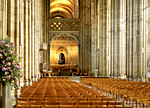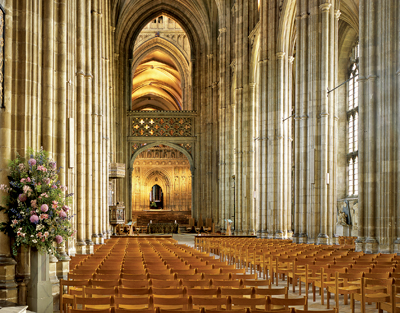Great British Architects: Henry Yevele died 1400
One of the most prolific architects of the Middle Ages, Yevele became a leading proponent of a new style – the Perpendicular


Yevele was one of the most prolific architects of the English Middle Ages, designing, advising on and overseeing the construction of a multitude of buildings, including churches, castles and bridges, across southern England and beyond. The breadth of his practice was a direct result of his employment as the king's principal mason from 1378, in the newly centralised building operations of the Crown.
Through this work, he became the leading pro-ponent of a new architectural style, the Perpendicular. It was characterised by the use of massive windows, consistent detail and the application of decorative grids of masonry that visually ordered and integrated the different elements of a building.
The pre-eminent quality of Yevele's work that appealed to a 14th-century audience was its uniformity. Before the age of industrial mass production, such consistency was hugely admired and the aesthetic preferences of the Perpendicular continued to shape English architecture into the 17th century.

Early career
Yevele was possibly born in Derbyshire, and is first documented in 1353, when he purchased the freedom of the City of London. It is not certain where he trained, but he evidently enjoyed a high standing as a mason in the capital, and, between 1357 and 1359, oversaw the costly reconstruction of the Black Prince's great hall at Kennington Manor. In 1360, he moved into Edward III's service as a ‘disposer' of masonry at both the Tower of London and Westminster.
If he was not already familiar with the royal building projects of the early 14th century, this experience must have made him so. In particular, he must have become familiar with the work of Edward III's leading mason, and the father of the Perpendicular style, William Ramsey (died 1349). When he worked in London, wider circumstances contrived to heighten the importance of royal building operations.
Not only did the Black Death drastically reduce the workforce, but many masons who survived this pandemic were impressed to work on Edward III's reconstruction of Windsor Castle, a seminal work in the Perpendicular style. These developments laid the foundations for Yevele's future influence and the triumph of the architectural style he worked in. King's mason
Sign up for the Country Life Newsletter
Exquisite houses, the beauty of Nature, and how to get the most from your life, straight to your inbox.
In 1378, following the accession of Richard II, a small body of men was effectively made responsible for all the king's building operations across the realm. In this arrangement was born what later became known as the Office of the King's Works, an institution that was to function for the next 400 years.
Yevele secured appointment as the senior mason in this body. This not only made him active on behalf of the king in all major building projects, but allowed him to freelance for a multitude of private clients. The loss of documentation obscures the full scale of his labours, but his surviving work for the Crown includes repairs to numerous castles, including Portchester and Westminster Hall.
He undertook a wide variety of architectural duties in these operations, such as providing designs (which other masons realised), quality-testing work, acting as consultant, and, in the case of the Neville Screen at Durham Cathedral, delivering a ready-made work of architecture from London to the north of England. Such was his amassed fortune that he paid for-and doubtless designed-a chapel on London Bridge, a structure central to London's identity and commercial life.
Yevele was also involved in tomb manufacture, and the operation of this business offers a fascinating insight into his working methods. He was part of a consortium that ran the most successful workshop producing monumental brasses in London.
The mass-produced output of this workshop, known as Series B brasses, is found all over the kingdom. Tomb production required a detailed exchange of information between client and the London-based workshop. As numerous contracts for tombs demonstrate, the medium for such exchange was drawing; ‘plats' or designs that patrons could agree to and craftsmen work from. A similar use of drawings must have underpinned his architectural work.
In 1946, a study of Yevele's career was published by John Harvey. He aimed to overturn the presumption that medieval buildings were created by anonymous craftsmen.
* For more features like this every week, subscribe and save
Country Life is unlike any other magazine: the only glossy weekly on the newsstand and the only magazine that has been guest-edited by HRH The King not once, but twice. It is a celebration of modern rural life and all its diverse joys and pleasures — that was first published in Queen Victoria's Diamond Jubilee year. Our eclectic mixture of witty and informative content — from the most up-to-date property news and commentary and a coveted glimpse inside some of the UK's best houses and gardens, to gardening, the arts and interior design, written by experts in their field — still cannot be found in print or online, anywhere else.
-
 Ford Focus ST: So long, and thanks for all the fun
Ford Focus ST: So long, and thanks for all the funFrom November, the Ford Focus will be no more. We say goodbye to the ultimate boy racer.
By Matthew MacConnell
-
 ‘If Portmeirion began life as an oddity, it has evolved into something of a phenomenon’: Celebrating a century of Britain’s most eccentric village
‘If Portmeirion began life as an oddity, it has evolved into something of a phenomenon’: Celebrating a century of Britain’s most eccentric villageA romantic experiment surrounded by the natural majesty of North Wales, Portmeirion began life as an oddity, but has evolved into an architectural phenomenon kept alive by dedication.
By Ben Lerwill